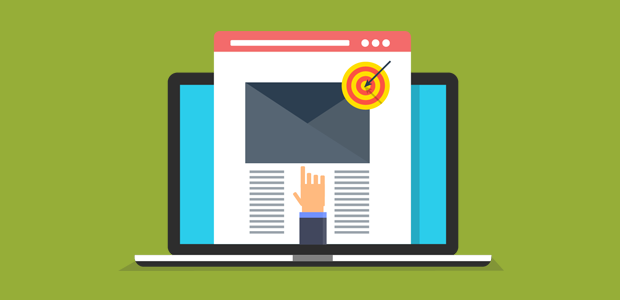Few channels are more effective than email when it comes to connecting with your audience. However, not all brands manage to do that. There are many obstacles you can encounter when marketing through email. Let’s take a look at some of them to see how you can overcome them and increase your email click-through rate.

What is your email click-through rate?
First, it’s best to understand exactly what your email click-through rate is and why this metric is so important. Your email click-through rate reflects how many people clicked on a link in your email – whether it’s a hyperlinked anchor, a call-to-action button, or an image.
According to Mailchimp, the average email click-through rate is 2.62%.
Certain emails will get low open rates, so clicks are subsequently low, as well. That’s a sign your list may not be as fresh as it was, or that other issues are affecting your deliverability.
Other emails will have a good open rate, but they won’t get people clicking through. The reason could be that your content needs some fine-tuning – especially your call-to-action buttons.
We’ll dive deeper into these topics below and see how you can ensure your emails land in your subscribers’ inboxes and entice them to click through your content.
You need an accurate, verified list
Email marketing is a complex puzzle: there are several elements that go into an effective program. One of the foundations is your email list and how clean it is.
To give you an idea, in just one year, about 22.5% of your email list decays, a study by Marketing Sherpa showed. That’s a large amount of data that becomes not just useless but also risky to your email deliverability.
How can you restore that data and prevent it from degrading? Validating all your contacts one by one is counterproductive and virtually impossible. While you may be able to manually remove some bad email addresses, the human eye can’t detect all of them.
A more efficient solution is to use an email validation service. With advanced algorithms and mechanisms, such services will remove several types of bad email addresses. Apart from bounces, email verifiers can detect catch-all, role-based, or temporary emails.
Having a fresh email list is vital to landing in the inbox and increasing your email click-through rate. So, if you haven’t cleaned your database in more than three months, consider doing it. It’s easy and worth the effort.
Your content makes all the difference
Take a look at your newsletters and email campaigns from the past few months. What were they mostly about? Do you notice more self-promotional emails or educational emails?
Here’s the thing: people subscribe to your list because you have something to offer that brings value to their lives and businesses. While they care about your products or services, they’re also likely to read informative, useful content. Keeping a healthy balance between the two is key to getting high open rates and boosting your click-through rates.
But what does a healthy balance mean? If you don’t have much experience with email marketing, how can you figure out the best content strategy?
Every audience is different, so the answer depends on that and the industry you’re in. A good rule of thumb is to send 80% educational content and 20% – and sometimes less – can be self-promotional emails and offers.
However, you may run some tests and find that your audience prefers to receive more promos. “Never stop testing and your advertising will never stop improving,” the great David Ogilvy said.
Spend more time on your call-to-action copy
Now that we covered your content strategy, let’s talk about one of the most important sections of your email: your call-to-action (CTA) anchor.
First, it’s worth noting that all of your content is important. Your subject line should get people to open your email. Then, the copy that goes into the body of your email should expand on your topic and create curiosity. Finally, your call-to-action button plays a vital role: it entices subscribers to click – or not.
There’s an art to writing emails that perform well. It’s called copywriting. You may not have enough experience to nail it right away, but regular practice helps.
Start by looking at some of the email calls-to-action that determined you to click. What was it that convinced you? Sometimes, changing one word can make the difference between someone clicking through or ignoring your CTA.
For instance, let’s say you write an email that promotes a new article on your blog. You write a short teaser and then, invite people to read more by clicking your CTA button. Instead of saying “Read more,” you could be specific and focus on the benefits people get when they go to your blog. Depending on your topic, you could say “Get more tips” or “Learn how to do it yourself.” Minor tweaks like that can increase your click-through rate and help you convert more.
Send your emails on time
How often do you send a newsletter or a promotional email? Some companies send a three emails a week when they run a promotion, then disappear from their subscribers’ inboxes for months. Don’t be one of them.
For email marketing to work, it needs persistence. You need to show up for your audience regularly, with great content. Why is this so important?
For one, it fosters better brand awareness: the more present you are in people’s inboxes, the more likely they are to remember you. When they become familiar with your brand, they engage more, which means higher open and click-through rates.
Also, sending emails regularly helps your inbox placement. Internet service providers (ISPs) support senders with predictable behaviors. If you send an email and then cease any activity for a few months, you’re taking ISPs by surprise. That could cause certain spam filters to go off and some of your emails to land in the spam folder.
So, whether you send a weekly or monthly newsletter, send it on time. Furthermore, if you’re running a campaign, avoid sending too many emails at once and instead, increase the volume slowly. Anything that looks suspicious in the eyes of ISPs can result in deliverability issues.
Conclusion
Increasing email click-through rates can take time. One day you may have a piece of content that many of your subscribers are curious about. You may see a spike in clicks only for them to drop when you send your next email.
The key is to get to know your audience so you can send content that’s in line with what people expect from you. Remember to maintain your list hygiene, polish your subject lines and call-to-action copy, and be consistent. Also, celebrate every little win: it’s a sign you’re improving and you’ll continue to get better.












Add Comment